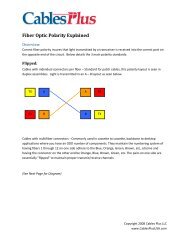Learning About Options in Fiber - Cables Plus USA
Learning About Options in Fiber - Cables Plus USA
Learning About Options in Fiber - Cables Plus USA
You also want an ePaper? Increase the reach of your titles
YUMPU automatically turns print PDFs into web optimized ePapers that Google loves.
SECTION 3—REFERENCES<br />
NRZI (nonreturn-to-zero,<br />
<strong>in</strong>verted) Code<br />
Numerical Aperture (NA)<br />
OLTS<br />
Optical Amplifier or Optical<br />
Repeater<br />
Optical Coupler<br />
Optical <strong>Fiber</strong> or Optical Waveguide<br />
Optical Loss Test Set (OLTS)<br />
Optical Time Doma<strong>in</strong><br />
Reflectometry (OTDR)<br />
Output Pattern<br />
Output Power<br />
Packet Assembler/ Disassembler<br />
(PAD)<br />
Packet Switch<strong>in</strong>g<br />
A modulation code where 0 is represented by a change <strong>in</strong> level, and a 1 is represented<br />
by no change <strong>in</strong> level. Thus, the level will go from high to low or from<br />
low to high for each 0. It will rema<strong>in</strong> at its present level for each 1. An important<br />
th<strong>in</strong>g to notice here is that there is no firm relationship between 1s and 0s of<br />
data and the highs and lows of the code. A b<strong>in</strong>ary 1 can be represented by<br />
either a high or a low, as can a b<strong>in</strong>ary 0.<br />
The mathematical measure of the fiber’s ability to accept lightwaves from<br />
various angles and transmit them down the core. A large difference between the<br />
refractive <strong>in</strong>dices of the core and the cladd<strong>in</strong>g means a larger numerical aperture<br />
(NA). The larger the NA, the more power that can be coupled <strong>in</strong>to the fiber.<br />
For short distances this is advantageous; however, for transmitt<strong>in</strong>g long distances<br />
the dispersion or pulse spread<strong>in</strong>g is too great.<br />
See Optical Loss Test Set.<br />
A device that receives low-level optical signals from an optical fiber, amplifies<br />
the optical signal, and <strong>in</strong>serts it <strong>in</strong>to an outbound optical fiber, without convert<strong>in</strong>g<br />
the signal to electrical pulses as an <strong>in</strong>termediary step.<br />
An optical device used to distribute light signals between multiple <strong>in</strong>put and<br />
output fibers.<br />
A glass or plastic fiber that has the ability to guide light along its axis.<br />
A source and power meter comb<strong>in</strong>ed to measure attenuation or loss.<br />
A method of evaluat<strong>in</strong>g optical fibers based on detect<strong>in</strong>g backscattered<br />
(reflected) light. Used to measure fiber attenuation, evaluate splice and connector<br />
jo<strong>in</strong>ts, and locate faults.<br />
The output pattern of the light is important to understand. As light leaves the<br />
chip, it spreads out. Only a portion actually couples <strong>in</strong>to the fiber. A smaller<br />
output pattern allows more light to be coupled <strong>in</strong>to the fiber. A good source<br />
should have a small emission diameter and a small NA. The emission diameter<br />
def<strong>in</strong>es how large the area of emitted light is. The NA def<strong>in</strong>es at what angles the<br />
light is spread<strong>in</strong>g out. If either the emitt<strong>in</strong>g diameter or the NA of the source is<br />
larger than those of the receiv<strong>in</strong>g fiber, some of the optical power will be lost.<br />
The optical power emitted at a specified drive current. An LED emits more<br />
power than a laser operat<strong>in</strong>g below the threshold. Above the las<strong>in</strong>g threshold,<br />
the laser’s power <strong>in</strong>creases dramatically with <strong>in</strong>creases <strong>in</strong> drive current. In<br />
general, the output power of a device is <strong>in</strong> decreas<strong>in</strong>g order: laser, edge-emitt<strong>in</strong>g<br />
LED, surface-emitt<strong>in</strong>g LED.<br />
A communications computer def<strong>in</strong>ed by the CCITT as the <strong>in</strong>terface between<br />
asynchronous term<strong>in</strong>als and a packet switch<strong>in</strong>g network.<br />
(1) A mode of data transmission <strong>in</strong> which messages are broken <strong>in</strong>to smaller<br />
<strong>in</strong>crements called packets, each of which is routed <strong>in</strong>dependently to the dest<strong>in</strong>ation.<br />
(2) The process of rout<strong>in</strong>g and transferr<strong>in</strong>g data by means of addressed<br />
packets, <strong>in</strong> which a channel is occupied only dur<strong>in</strong>g the transmission of the<br />
packet; the channel is then available for other packets.<br />
3-14
















